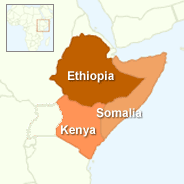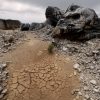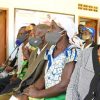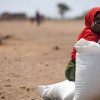
Author and Page information
- This page: https://www.globalissues.org/article/796/east-africa-food-crisis.
- To print all information (e.g. expanded side notes, shows alternative links), use the print version:
On this page:
Introduction
 Into mid-2011, the world’s worst food crisis is being felt in East Africa, in Ethiopia, Somalia and Kenya.
Into mid-2011, the world’s worst food crisis is being felt in East Africa, in Ethiopia, Somalia and Kenya.
Despite successive failed rains, the crisis has been criticized as avoidable and man-made. This is because the situation had been predicted many months before by an international early warning system. Both the international community and governments in the region have been accused of doing very little in the lead up to this crisis. In addition, high food prices have forced food out of the reach of many people, while conflict in Somalia has exacerbated the situation.
As the international organization Oxfam describes: 12 million people are in dire need of food, clean water, and basic sanitation. Loss of life on a massive scale is a very real risk, and the crisis is set to worsen over the coming months, particularly for pastoralist communities.
Early warning systems had predicted this months earlier
As Inter Press Service (IPS) reported, despite the conflicts in the region,
The world had an opportunity to save thousands of lives that are being lost in parts of Somalia due to the famine, if only the donor community had paid attention to the early warning systems that predicted it eight months ago.
…
There has been a catastrophic breakdown of the world’s collective responsibility to act. 3,500 people a day are fleeing Somalia and arriving in parts of Ethiopia and Kenya that are suffering one of the driest years in six decades. Food, water and emergency aid are desperately needed. By the time the U.N. calls it a famine it is already a signal of large scale loss of life,Oxfam said.
Knowing about these things in advance is significant in terms of lives, costs and preparedness. The US government agency USAID’s Famine Early Warning System Network had predicted the crisis in November 2010, noting that
food security outcomes are likely to worsen, particularly among the poorest households whose coping capacity is the most limited.
In areas at‐risk of worsening food security, households may require livelihood support to prevent asset loss, household food deficits, and negative coping. Potential interventions in pastoral areas include rehabilitation of water points (boreholes), increased veterinary services targeting the dry season grazing areas, commercial off‐take programs, and nutrition support programs targeting poorer households. In the cropping southwest marginal areas of Kenya, and in Rwanda and Burundi, the scale‐up of resource transfer programs may be required to minimize the food security impacts of the La Niña event [that was observed at the end of 2010].
Massive funding shortfall — assuming anyone cares
As international humanitarian and development organization Oxfam explained, many (often simple) preventative actions could have been taken, assuming funds were available earlier:
Whenever there is an indicator of such a disaster, we must not only sit and wait for the emergency response. We can conveniently invest the funds by putting irrigation systems in place, vaccinating people, especially children, against anticipated diseases, and creating proper infrastructure to be used in case there is need for food supply,said [Anna Ridout, Oxfam’s spokesperson]
But, as Oxfam notes in another article, donors and governments fail to deliver on East Africa aid effort:
The overall humanitarian requirements for the region this year, according to the UN appeals, are $1.87 billion. These are so far 45 percent funded, leaving a gap of over $1 billion still remaining: gaps of $332m and $296m for the Kenya and Somalia UN appeals respectively, and $398m for the government-run appeal in Ethiopia
In the last two weeks there have been new pledges of $205m, leaving a gap of $800m still remaining.
The UK has pledged an estimated $145m in the past two weeks – almost 15 percent of what is needed. The EU has pledged around $8m so far, with more expected in the coming days. Spain has pledged nearly $10m, Germany around $8.5m. France has so far not pledged any new money, and Denmark and Italy have said no significant new sums are available.
But it is not just the international community. Various actors in the region also face criticism and question. For example, as the above IPS article had also noted, the effects of the drought were made worse by the Al Shabaab militia group in Somalia, which had blocked donor agencies from operating within its territories in 2009 — now the famine zones. Admittedly, the extremist group recently lifted its ban, as IPS also noted.
Another example is the governments of the affected countries as well as the African Union. Ugandan journalist, Rosebell Kagumire, writing for Oxfam, noted that the African Union had complained about lack of funds because governments have not put enough money in. Although Kenya opened its borders for an influx of Somalian refugees, Kagumire criticized the response as lacking urgency and not being effective.
One of the worst crises in recent history
The crisis is one of the worst in recent history:
Compared to previous famines, the current situation in Somalia compares or exceeds those reported during recent years in Niger (2005), Ethiopia (2001), Sudan (1998) and Somalia (1992). However, this is the most severe food security crisis in Africa since the 1991/92 Somalia famine, according to the U.N. Between January and June this year, 300,000 people in Mogadishu were given food assistance by humanitarian agencies on a monthly basis. Approximately 100,000 malnourished children were treated through some 418 nutrition centres in south Somalia from January to May 2011.
…
The current crisis in Somalia is expected to have an increasingly devastating effect on other countries in the region. However, generally, the Horn of Africa has 11.5 million people in crisis, including the 3.7 million in Somalia.
Somewhat predictably, media coverage seems spotty. At times there are detailed reports, often responding to government and other large international agency pushes to address the crises. Other times, the coverage vanishes from mainstream headlines and prime time viewing almost as soon as reporting has started.
On the morning of Sunday, July 31, during a review of British Sunday newspapers by the BBC, commentators noted how only one paper had a front page story about this crisis while almost all of them had something about a second Royal wedding. (It wasn’t necessarily ignoring Africa, either, as the also important story about the US debt crisis also barely featured on any papers headlines!)
And of course, most of the reporting has followed after the crisis has happened.
It is also interesting to note how quickly the international community
mobilized against Libya with military and other actions, when far less people (in number) were affected.
More information
For more about the issues from other organizations, here are some starting points:
News stories from IPS
Below is a list of stories from Inter Press Service as they cover this event. Revisit this page frequently to see newer stories as the crisis unfolds:
-
Severe drought threatens 13 million with hunger in Horn of Africa
– UN News

An estimated 13 million people are waking up severely hungry every day in the Horn of Africa, as the region grapples with a major drought caused by the driest conditions since 1981, the World Food Programme (WFP) warned on Tuesday.
-
No Perfect Solution: Africa’s Smallholder Farmers Must Use Both Traditional and New Practices
– Inter Press Service

Feb 07 (IPS) – As an agricultural and environmental scientist, I’ve worked for decades exploring the practical challenges that smallholder farmers encounter in East Africa. These include controlling weeds that can choke their crops and looking for new ways to deal with pests or diseases that threaten their harvests.
-
Heatwave and Drought Hit South America’s Crops and Economy
– Inter Press Service

BUENOS AIRES, Jan 26 (IPS) – Brazil, Argentina and Paraguay, the three major agricultural producers in South America, are currently experiencing a prolonged period of drought and low water levels in their main rivers. This is severely impacting harvests, as well as river transport of important summer crops, with maize and soybeans the main casualties.
-
FAO launches $138 million plan to avert hunger crisis in Horn of Africa
– UN News

More than $138 million is needed to assist rural communities affected by extended drought in the Horn of Africa, the UN Food and Agriculture Organization (FAO) said on Monday, launching a comprehensive response plan for the region.
-
In Africa, Vaccine Delayed is Development Denied, Warns UNDP Head
– Inter Press Service

UNITED NATIONS, Dec 20 (IPS) – The 21-month-long corona virus pandemic has triggered three new phrases in the UN lexicon: “vaccine famine, vaccine apartheid and vaccine nationalism”.
And the largest number of victims facing the triple threats are from developing countries, mostly in Africa, as reflected in grim statistics.
-
Worsening drought affects 2.3 million people in Somalia
– UN News

With about 2.3 million people already suffering with serious water, food and pasture shortages in Somalia, a rapidly worsening drought could lead to an “extreme situation” by April next year.
-
Ethiopia: Future of Tigray and Horn of Africa ‘in grave uncertainty’
– UN News

A year-long conflict in the Tigray region of Ethiopia has reached “disastrous proportions”, the UN political chief told the Security Council on Monday, warning of “grave uncertainty” surrounding the future of the country and stability of the whole Horn of Africa region.
-
WFP warns 3 million more now ‘teetering on the edge of famine’
– UN News

The UN World Food Programme (WFP) warned on Monday that the number of people teetering on the edge of famine in 43 countries, has risen to 45 million – up by three million this year – as acute hunger spikes around the world.
-
In Madagascar, pockets of famine as risks grow for children, warns WFP
– UN News

“Pockets of famine” have now been reported in Southern Madagascar, the UN World Food Programme (WFP) said on Tuesday.
-
Madagascar: Severe drought could spur world’s first climate change famine
– UN News

More than one million people in southern Madagascar are struggling to get enough to eat, due to what could become the first famine caused by climate change, according to the World Food Programme (WFP).
-
Stopping the march towards famine: A UN Resident Coordinator blog
– UN News

Seven years into a brutal conflict, Yemen is heavily dependent on humanitarian assistance, but the UN is intent on avoiding a repeat of the worst periods of famine and malnutrition its citizens have suffered. On a recent visit to UN headquarters in New York, David Gressly, the UN Resident and Humanitarian Coordinator for Yemen, told UN News that, although emergency funds have been received, the humanitarian response remain severely underfunded.
-
Drought, Storms, Intense Rainfall and Fires Threatening Millions in Latin America and the Caribbean
– Inter Press Service

NEW YORK, Aug 24 (IPS) – In 2020, Brazil, Paraguay and Bolivia faced their worst drought in half a century. The Atlantic Basin saw 30 named storms – the most recorded in a single year. Two category 4 hurricanes achieved an unprecedented feat by making landfall in Nicaragua.
-
Hospitals barely functioning, famine still looming in Ethiopia’s Tigray region
– UN News

UN humanitarians expressed concern on Tuesday at the uncertain situation in Ethiopia’s conflict-ravaged Tigray region despite a ceasefire call from the Government, highlighting the ongoing famine-like conditions there and the potential for disease outbreaks.
-
Famine knocking at the door of 41 million worldwide, WFP warns
– UN News

Famine is already present in four countries but millions more people are at risk, the World Food Programme (WFP) warned on Tuesday, underscoring the need for urgent funding and humanitarian access to reach those in need.
-
Famine risk spikes amid conflict, COVID-19 and funding gaps: WFP
– UN News

The impact of conflicts old and new, climate shocks and COVID-19, in addition to a lack of funding, have left millions more on the verge of famine than six months ago, the World Food Programme (WFP) said on Friday.
-
Call for Political Belt-tightening to Prevent Drought Becoming the Next Pandemic
– Inter Press Service

BHUBANESWAR, India, Jun 17 (IPS) – June 17 is World Day to Combat Desertification and Drought. A new report shows that climate change, overuse and conversion for agriculture, cities and infrastructure, which also drive drought and desertification, have already degraded one fifth of the planet’s land area.
“Drought is on the verge of becoming the next pandemic and there is no vaccine to cure it.”
-
UN chief: Desertification and drought destabilizing well-being of 3.2 billion people
– UN News

Land degradation from climate change and the expansion of agriculture, cities and infrastructure “undermines the well-being of 3.2 billion people”, the UN chief said on Wednesday in his message for World Day to Combat Desertification and Drought.
-
UN agencies scale-up response to address looming famine ‘catastrophe’ in Tigray
– UN News

The head of the World Food Programme (WFP) appealed on Thursday for immediate access to deliver lifesaving assistance to Ethiopia’s Tigray region, where ongoing fighting between government and regional forces has put some 350,000 people at risk of famine.
-
Successful Crop Innovation Is Mitigating Climate Crisis Impact in Africa
– Inter Press Service

IBADAN and MEXICO CITY, Feb 17 2021 (IPS) – 17 February – African smallholder farmers have no choice but to adapt to climate change: 2020 was the second hottest year on record, while prolonged droughts and explosive floods are directly threatening the livelihoods of millions. By the 2030s, lack of rainfall and rising temperatures could render 40 percent of Africa’s maize-growing area unsuitable for climate-vulnerable varieties grown by farmers, while maize remains the preferred and affordable staple food for millions of Africans who survive on less than a few dollars of income a day.
-
Madagascar edges toward famine, UN food agency appeals for assistance
– UN News
An unrelenting drought in southern Madagascar, an island State off the East African coast in the Indian Ocean, is forcing hundreds of thousands to the brink of famine at a scale “beyond belief”, a senior UN food agency official said on Thursday.
-
Yemen – Worst Famine World has Seen in Decades Predicted
– Inter Press Service

UNITED NATIONS, Feb 19 (IPS) – Yemen is heading towards the worst famine the world has seen in decades, the United Nations Security Council was warned in a briefing yesterday.
-
Successful Crop Innovation Is Mitigating Climate Crisis Impact in Africa
– Inter Press Service

IBADAN and MEXICO CITY, Feb 17 (IPS) – 17 February – African smallholder farmers have no choice but to adapt to climate change: 2020 was the second hottest year on record, while prolonged droughts and explosive floods are directly threatening the livelihoods of millions. By the 2030s, lack of rainfall and rising temperatures could render 40 percent of Africa’s maize-growing area unsuitable for climate-vulnerable varieties grown by farmers, while maize remains the preferred and affordable staple food for millions of Africans who survive on less than a few dollars of income a day.
-
UN Warns of an Impending Famine With Millions in Danger of Starvation
– Inter Press Service

UNITED NATIONS, Nov 27 (IPS) – The numbers are staggering — as reflected in the ongoing coronavirus pandemic which has triggered a new round of food shortages, famine and starvation.
-
Living with Drought: Lessons from Brazil’s Semiarid Region
– Inter Press Service

RIO DE JANEIRO, Oct 23 (IPS) – No one died of hunger during the worst drought in Brazil’s semiarid ecoregion, between 2011 and 2018, in sharp contrast to the past when scarce rainfall caused deaths, looting, a mass exodus to the South and bloody conflicts.
-
Safeguarding Africa’s Food Security in the Age of COVID-19
– Inter Press Service

Jun 05 (IPS) – Food security in sub-Saharan Africa is under threat. The ability of many Africans to access sufficient, safe and nutritious food to meet their dietary needs has been disrupted by successive natural disasters and epidemics. Cyclones Idai and Kenneth, locust outbreaks in eastern Africa, and droughts in southern and eastern Africa are some examples. The COVID-19 pandemic is just the latest catastrophe to have swollen the ranks of 240 million people going hungry in the region. In some countries, over 70 percent of the population has problems accessing food.
-
Desert Locusts Invade East Africa
– Inter Press Service

NAIROBI, Feb 14 (IPS) – Widespread hatching and movement of destructive desert locusts will turn into a full-blown crisis in the coming weeks in East Africa and neighbouring countries, the UN Food and Agriculture Organization warns.
-
Insurance Scheme Offers Hope for Drought-stricken African Farmers
– Inter Press Service

UNITED NATIONS, Oct 24 (IPS) – A partnership between United Nations and African Union (AU) agencies will help African economies insure themselves against the droughts and other extreme weather events that plague the continent, organisers say.
-
Agro-tech Offers Answers for African Farmers at Iowa Meet
– Inter Press Service

DES MOINES, United States, Oct 21 (IPS) – Experts vaunted new strains of seeds, drone aircraft and other technological breakthroughs as solutions-in-the-making for farmers in Africa, where hunger, drought and food price hikes are continent-wide problems.
-
Horn of Africa Drought Threatens Re-run of Famines Past
– Inter Press Service

UNITED NATIONS, Jul 25 (IPS) – Humanitarian groups and the United Nations are warning of another drought in the Horn of Africa, threatening a repeat of the deadly dry spell and famine that claimed lives in Somalia and its neighbours eight years ago.
-
Drought, Disease and War Hit Global Agriculture, Says U.N.
– Inter Press Service

UNITED NATIONS, Jul 11 (IPS) – The United Nations has warned of drought, disease and war preventing farmers from producing enough food for millions of people across Africa and other regions, leading to the need for major aid operations.
Author and Page Information
- Created:
